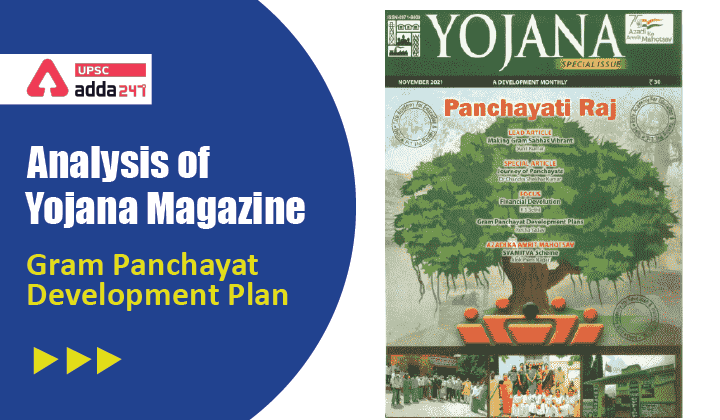Table of Contents
Introduction
- Over the past few decades, there have been significant developments in the devolution of powers to Gram Panchayats (GPs) to realise this mandate and allow more control over development to people through elected GPs.
- Article 243G of the Indian Constitution mandates economic development and social justice through an inclusive, community-driven, and holistic planning process of the Panchayat System, thereby evolving into institutions of local self-governance
What is Gram Panchayat Development Plan (GPDP)?
- It was institutionalised during the FY 2015-16.
- It works as a vehicle for comprehensive and convergent development planning.
- GPDP process facilitates decentralised planning by the community members of the village.
- The convergence of resources available through various schemes of the Government of India and respective State governments as well as ‘Own-source Revenue’ provide the opportunity to the Gram Panchayats to chart their own need-based development plans through active involvement of the Gram Sabha.
Broad Objectives of GPDP
- To ensure integrated and inclusive development of the rural areas governed by Gram Panchayats, which is not only geared towards infrastructure oriented development but also social, economic, and community development.
- To enable and engage the community in participatory planning and decision-making processes.
- To ensure identification of locally available resources and addressing local needs of all communities through participatory planning and convergence.
- To ensure inclusion and welfare of the Scheduled Tribes, Scheduled Castes, and other marginalised communities, Other Backward Communities, women and children, vulnerable groups, people with disabilities, etc., in the formulation and implementation of the GPDP to ensure the provision of basic social goods and a life of dignity.
- To improve efficiency and efficacy in public service delivery in local areas.
- To strengthen accountability measures at the local level.
What is Incentivisation of Panchayats?
- MoPR introduced Panchayat Empowerment and Accountability Incentive Scheme (PEAlS) during the year 2005-06 for States/UTs towards their performance on the extent of devolution carried out by them.
- Thus, PEAlS acted as a centralised intervention for decentralisation by States through devolution.
What is Rajiv Gandhi Panchayat Sashaktikaran Abhiyan (RGPSA)?
- To provide panchayats with adequate technical and administrative support, strengthen their infrastructure and e-enablement, promote devolution, and improve their functioning, centrally sponsored scheme of Rajiv Gandhi Panchayat Sashaktikaran Abhiyan (RGPSA) scheme was approved and launched during the year 2013-14.
- Key Objectives:
- Enhance capacities and effectiveness of Panchayats and the GramSabhas;
- Enable democratic decision-making and accountability in Panchayats and promote people’s participation;
- Strengthen the institutional structure for knowledge creation and capacity building of Panchayats;
- Promote devolution of powers and responsibilities to Panchayats according to the spirit of the Constitution and PESA Act.
- Strengthen Gram Sabhas to function effectively as the basic forum of people’s participation, transparency and accountability within the Panchayat system;
- Create and strengthen democratic local self-government in areas where Panchayats do not exist;
- Strengthen the constitutionally mandated framework on which Panchayats are founded.
What is National Panchayat Awards?
- The National Panchayat Awards under the Incentivisation of Panchayats scheme are conferred annually on 24 April.
- This event highlights the winning panchayats as role models for others as an inspiration.
- Categories of the Awards
- Nanaji Deshmukh Rashtriya Gaurav Gram Sabha Puraskar (NDRGGSP): The main objective of instituting this award is to strengthen the institution of Gram Sabha and to highlight it as the institution for people’s participation, collective decisions, and social audit. This award is given to one GP/Village Council (VC) in each State/UT with award money of Rs 10 lakh each.
- Deen Dayal Upadhyay Panchayat Sashaktikaran Puraskar (DDUPSP): DDUPSP is given for general (for all PRIs) and 9 thematic categories (only for GPs).
- e-Panchayat Puraskar: It is given to incentivise States/ UTs to adopt and implement the Panchayat Enterprise Suite (PES) Applications/State specific Applications, automate the internal workflow processes of panchayats and equivalent Rural Local Governments, enable electronic delivery of services making them more transparent, accountable and effective as organs’ of decentralised self-governing institutions through adoption and implementation of the e-Panchayat Applications. There is no financial incentive under this award.



 TSPSC Group 1 Question Paper 2024, Downl...
TSPSC Group 1 Question Paper 2024, Downl...
 TSPSC Group 1 Answer key 2024 Out, Downl...
TSPSC Group 1 Answer key 2024 Out, Downl...
 UPSC Prelims 2024 Question Paper, Downlo...
UPSC Prelims 2024 Question Paper, Downlo...





